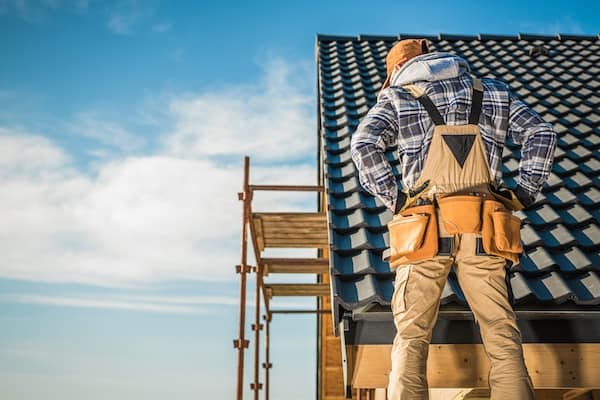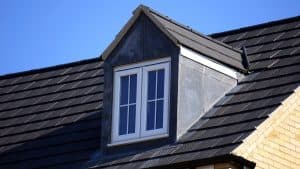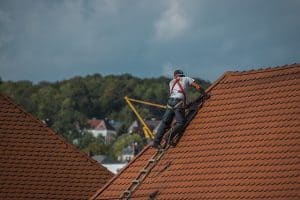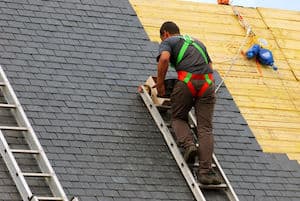What is a roof inspection? A Complete Guide
Owning a home can be one of the most rewarding decisions in life. However, with the decision to own a home comes many responsibilities. And these responsibilities usually come with a price tag and require either a contractor to come out and take care of them or a lot of time and effort on your part to find DIY solutions.
Inspecting your roof can be a costly endeavor. Most contractors charge $200 or more to inspect a roof, and if nothing is wrong, you’re out of a good chunk of change for it. If you’re up for the challenge, DIY roof inspections can save you a lot of money, in exchange for some time and energy.
Here are the steps you’ll need to follow in order to inspect your roof on your own:
- Prepare to Perform the Roof Inspection
- Invest in the Proper Roof Inspection Equipment
- Learn What You Should Look for When Inspecting a Roof
- Consult with a Professional Roof Inspector When Necessary
 Step 1: Preparing to Perform a Roof Inspection
Step 1: Preparing to Perform a Roof Inspection
When you decide to take the leap and DIY your roof inspection, the first thing to consider is prepping your house and yourself for the inspection. There are some safety concerns with getting up to your roof and walking along your roof.
The Safety of Roof Inspection
Walking along your roof while inspecting it creates a precarious situation. If your roof is slanted (I’m willing to bet that it is), one small misstep or slip can send you tumbling down the incline and off the side of your house.
The way you get up on the roof is a concern as well. You need an adequate ladder to climb safely and securely to your roof before you can ever check your roof for structural weaknesses.
The Equipment You’ll Need to Inspect Your Roof
The point of DIYing your roof inspection is to save money. However, there are some items you will need to obtain to make sure you stay safe while doing the inspection. If you end up in the hospital because you didn’t take the necessary precautions ahead of time, you will end up spending way more than just hiring a contractor to inspect your roof for you.
There are a few items you need to make sure you’re safe while atop your house, including a roof anchor, rope, lanyard, and safety harness. An extension ladder is also required to get on top of your house.
These items can be bought from your local hardware store and can be a worthwhile investment for many other situations, such as installing gutters, hanging Christmas lights, and inspecting your chimney (see this article to learn more about chimney inspections).
Another money saver is the fact that all this gear will last at least a decade before you will need to replace any of it. If you don’t feel comfortable with any of this, don’t be ashamed to call a contractor to help you with the inspection.
Step 2: What to Do You Need to Inspect on Your Roof
Now that you have all the items necessary to stay safe while doing the inspection, you’re ready to get up there and do the inspection. To inspect effectively, you need to know what to look for and what to feel for. Generally, you need to check for any damaged or missing shingles, the flashings around any windows or vents, and the structural integrity of your fascia, soffits, and plywood.
Shingles
Your shingles play a vital role in the structure of your roof. They protect your roof from the elements while also covering the seams between plywood boards on top of your home.
If any shingles are damaged or missing, this can allow water and debris to get under other shingles and erode the plywood, causing leaks and allowing small creatures to make their way into your attic.
Flashings
Flashings are metal sheets added to the outside of any holes cut in your roof for skylights, windows, vents, and ductwork. This helps direct water away from the seams and reinforces the structure around the vent or skylight.
These can rust and get bent by small animals and debris throughout the year. The damage can lead to leaks around vents and ductwork as well as structural issues for skylights and other large cutouts in your roof.
Fascia
The boards that run along the underside of the edge of your roof is called fascia. These boards are usually where gutters are attached and are most susceptible to water damage.
The rotting wood can be dangerous if your gutter is attached, as the weight of the gutter can rip the screws out of the soft, rotted fascia. One easy way to recognize this is to look for sagging sections of your gutter.
Soffit
The soffit is the wood under the part of the roof that hangs over the edges of your house. This wood helps to maintain the structure of your roof and to direct water and debris away from your house. If the wood begins to rot or fall out of place, your roof can sag and the fascia has no reinforcement.

Step 3: What to Look For When Inspecting Your Roof
When inspecting your roof, you need to know what is good and bad about your roof. The main things to look at when inspecting your roof are structural integrity, drainage, leaks, and rotting wood.
These things are the most prominent things that lead to roof issues. Catching them early can ensure that your home stays safe throughout the year.
Structural Integrity
The structural integrity of your roof is vital to your entire home’s structural integrity. If your roof has structural issues, it can lead to shifting of walls in your home, holes that animals can crawl in, and eventually collapse of the roof if these issues are not addressed.
When walking atop your roof, be very mindful of any flex in the roof. This may be a sign of water damage under the shingles. When checking the fascia and soffit on the edge of your roof, the same issues may be present, causing issues with drainage and gutters.
Drainage
Your roof is designed to direct water and debris away from your house. At the point where two sections of the roof meet, there is usually an angled metal strip to direct water down to the gutters and away from any openings in your roof, such as vents and ductwork.
If these metal strips are damaged or clogged with debris, this can lead to leaks and rotting wood. Be sure to periodically check for debris in major flow areas on your roof and remove any debris from wind and storms from these areas to ensure proper drainage.
Leaks
Before getting up on your roof, check inside your house for any water stains on the ceiling and take note of the general area within the house that you saw the stain. If you’re already on your roof, take a break and check for any water stains that indicate roof leaks.
Anywhere that you found structural issues on the roof could be causing a leak into your attic and your home. If any shingles are damaged or missing, this could indicate a leak in your roof as well. Check the general areas where you noted water stains inside to find the source of the water that is invading your home.
Rotting Wood
The biggest concern when you find a leak is water damage in the wood under your shingles. If you feel a flex in the wood, more than likely, it has been softened by excess water from storms. These structural issues are a serious concern and need to be handled as quickly as possible to stop the spread of the rotting and keep your roof from caving in.
This is usually a cause for getting a brand new roof, so it’s time to call the professionals in to give you an estimate on the repair. They have the tools and manpower to fix your roof fast and get your house back to its original state.

Step 4: Consult a Professional Roof Inspector
If you have found anything serious when inspecting your roof, or if you have realized that the daunting task of inspecting your roof is too much for you, the pros are here to help you out. Calling a roofing company to come out to your home and give you a honest and expert opinion is great.
They know exactly where to look and what to look for on your roof to inspect it thoroughly. After they assess the issues, they can address any concerns as well as go through what it will take to repair any leaks or structural weak points.
From there, they give you a quote on the repair job. If and when you agree, they can get to fixing these roof issues and assure you that your home is taken care of.
Inspecting your roof is not an easy job, but doing the inspection yourself can bring you peace knowing that your home is covered. It can also save you money if you don’t find any issues during your inspection.
Hiring a roofing company to inspect your roof for you can also give you peace knowing that the experts are making sure the inspection is done right. So either way that you choose, you know that your roof is covered.
On the Rock Roofing is a roofing company that has a great team of experienced roofers. They service Broken Arrow, Tulsa, and the surrounding areas with their roofing expertise and give their homeowner clients the peace of knowing their roof is covered.

